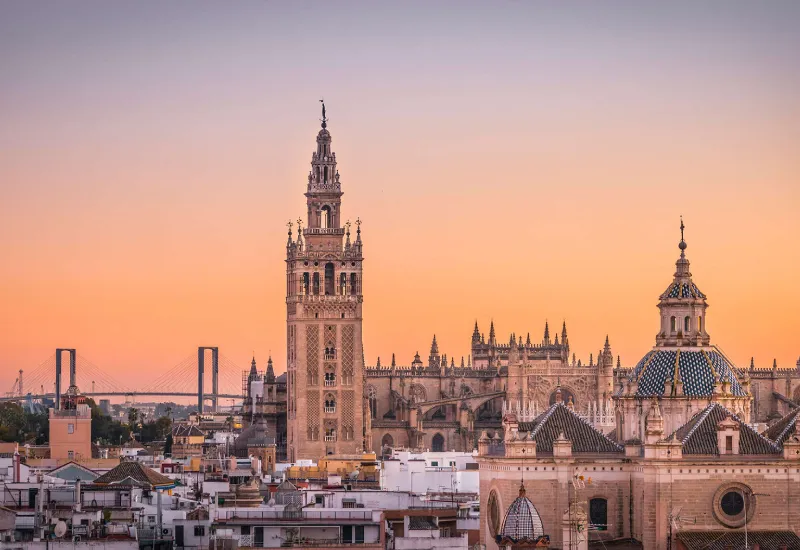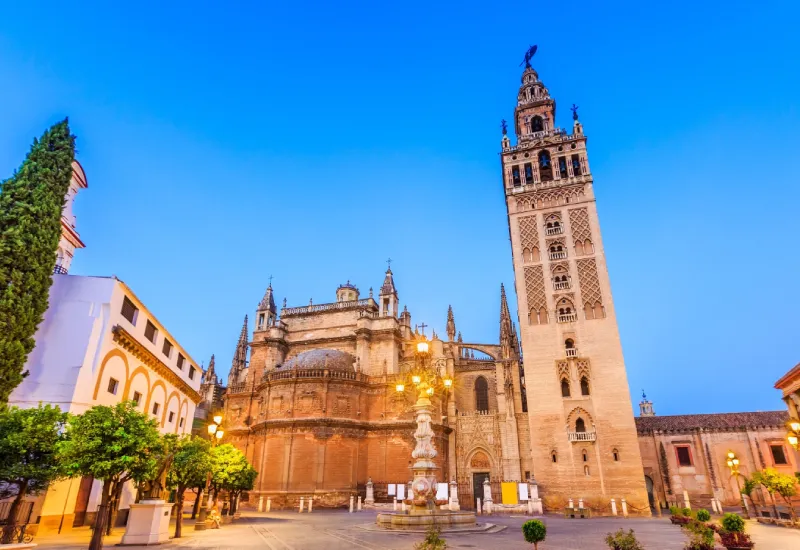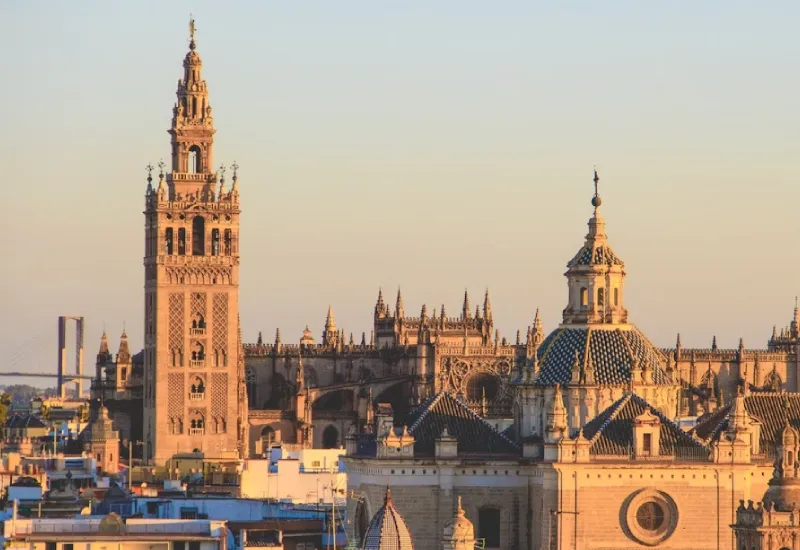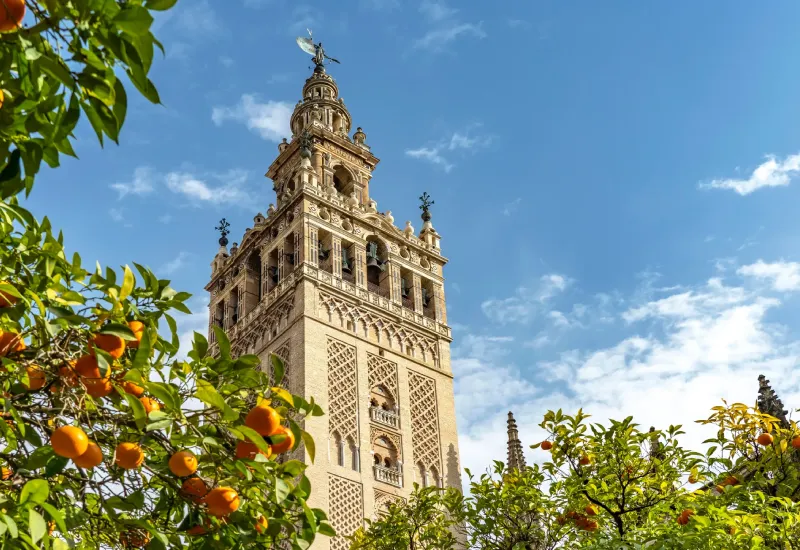The Giralda Tower (La Giralda) is one of the most iconic landmarks in Seville, Spain. Standing proudly beside the Seville Cathedral, this towering structure encapsulates the city’s vibrant history, where Islamic and Christian influences blend seamlessly. With its remarkable architecture and centuries-old legacy, La Giralda has become a must-visit tourist attraction and a proud symbol for locals. This article is about the fascinating story of La Giralda, exploring its origins, architectural significance, cultural value, and its enduring charm.
Table of Contents
ToggleHistory of La Giralda
La Giralda has a rich history from the 12th century. And now we want to talk about the rich history of La Giralda. Stories that are very popular in Seville and are told among the locals.
Origins in the Almohad Period
The story of La Giralda begins in the 12th century, during the Almohad rule of southern Spain. The Almohads were a Berber Muslim dynasty known for their architectural and engineering prowess, and Seville was a key city in their empire.

In 1171, Caliph Abu Yaqub Yusuf commissioned the construction of a grand mosque in Seville to demonstrate the power and sophistication of his rule. The minaret, later known as La Giralda, was an integral part of this mosque. Completed in 1198, the tower was modeled after the Koutoubia Mosque in Marrakesh, Morocco, and remains a testament to the ingenuity of Islamic architecture.
The Almohad minaret featured intricate geometric designs, symmetrical proportions, and a sturdy yet elegant structure. It was not only a place for the muezzin to call the faithful to prayer but also a symbol of the city’s prominence.
Conversion to a Bell Tower
The Reconquista marked a significant turning point for La Giralda. In 1248, Seville was captured by Christian forces under Ferdinand III of Castile. The mosque was consecrated as a cathedral, and over time, its Islamic features were modified to align with Christian traditions.
In the 16th century, architect Hernán Ruiz transformed the minaret into a bell tower. He added a Renaissance-style belfry, enhancing its height and introducing ornate Christian elements.
At the top, he placed a bronze statue called El Giraldillo, which functions as a weather vane. This addition marked the tower’s symbolic transition from its Islamic origins to its Christian identity.
La Giralda Architecture (Islamic and Christian Styles)
La Giralda is a masterpiece of architectural fusion. The lower section, built during the Almohad period, reflects the sophistication of Islamic art. Its intricate brickwork, horseshoe arches, and repetitive geometric patterns showcase the beauty of Moorish design.

In contrast, the upper section, added during the Renaissance, features decorative balustrades, columns, and ornamental windows that reflect the Christian influence. Despite the stark differences, the styles blend harmoniously, creating a unified and timeless structure.
Ingenious Engineering
The tower stands 104 meters (341 feet) tall, making it one of the tallest buildings of its time. Its design is both functional and innovative. Instead of stairs, the tower features a series of 35 ramps, wide enough for horses to ascend to the top. This ingenious solution allowed the muezzin to climb the tower with ease.
The ramps also provide a unique experience for modern visitors, who can walk up to them to enjoy breathtaking views of Seville from the top.
La Giralda UNESCO World Heritage Site
In 1987, La Giralda, along with the Seville Cathedral and the Royal Alcazar, was designated a UNESCO World Heritage Site. This prestigious recognition highlights the tower’s historical and cultural importance, as well as its architectural brilliance.
As a symbol of Seville, La Giralda represents the city’s ability to adapt and thrive through centuries of change while preserving its unique identity.
La Giralda has inspired numerous replicas and adaptations worldwide. The most notable examples include the Giraldilla of Havana in Cuba and the clock tower at the Biltmore Estate in the United States. These adaptations underscore the tower’s global influence and enduring legacy.

Exploring La Giralda
La Giralda is a highlight of any trip to Seville. Visitors can access the tower as part of a visit to the Seville Cathedral. The experience begins with a tour of the cathedral, one of the largest Gothic churches in the world, before ascending the tower’s ramps.
The climb is rewarding, offering panoramic views of Seville’s skyline, including the Guadalquivir River, the Royal Alcázar, and the vibrant streets of the Santa Cruz neighborhood.
Best Times to Visit
To avoid crowds, consider visiting La Giralda early in the morning or later in the afternoon. The tower is also particularly stunning at sunset when the city is bathed in golden light, making it an ideal time for photography.
Facts About La Giralda
Below are some random facts about Giralda Tower that you might find interesting, from the El Giraldillo Statue to what Giralda means.
The El Giraldillo Statue
The statue of El Giraldillo is one of the most distinctive features of La Giralda. Standing 4 meters tall and weighing over a ton, the bronze figure represents the triumph of faith. It functions as a weather vane, gracefully rotating with the wind.
Meaning of La Giralda
The name “Giralda” comes from the Spanish word “girar,” meaning “to turn,” referring to the rotating El Giraldillo statue. Over time, the entire tower became synonymous with this iconic feature. Also, Giralda in English means Weather-cock which is the form of a statue.
A Nighttime Marvel
La Giralda is even more magical at night. The tower is beautifully illuminated, emphasizing its intricate details and majestic presence. A nighttime stroll around the Seville Cathedral is a romantic and serene way to appreciate the tower’s beauty.

Nearby Attractions
La Giralda is close to the Seville Cathedral, and if you like, you can see these tourist attractions together. There are many Nearby Attractions, some of the most famous ones are listed below.
Seville Cathedral
As the tower’s companion, the Seville Cathedral is a marvel in its own right. Its stunning Gothic architecture, vast interior, and treasures such as Christopher Columbus’s tomb make it a must-see.
The Royal Alcázar
A short walk from La Giralda lies the Royal Alcázar, a magnificent palace complex that showcases a blend of Mudéjar, Gothic, and Renaissance styles. Its lush gardens and ornate interiors transport visitors to a bygone era.
Barrio Santa Cruz
The charming neighborhood of Santa Cruz Seville is another nearby gem. Its narrow streets, picturesque courtyards, and vibrant atmosphere provide a glimpse into Seville’s traditional character.
Conclusion
The Giralda Tower is much more than an architectural wonder—it is a living monument to Seville’s dynamic history. From its origins as a Muslim minaret to its transformation into a Christian bell tower, La Giralda embodies the cultural crossroads that have shaped the city.
Today, it stands as a beacon of Seville’s enduring spirit, attracting visitors from around the world. Whether you are drawn by its historical significance, architectural beauty, or stunning views, La Giralda promises an unforgettable experience.
When planning your next trip to Seville, make sure to include a visit to this extraordinary landmark—it’s a journey through time and a celebration of the city’s unique heritage.
Are you planning to visit Europe and looking for a Europe Travel Agency? Check out our Europe Tours and Feel free to contact us.







